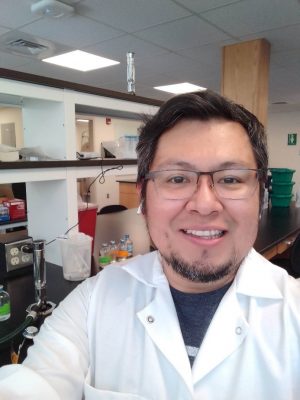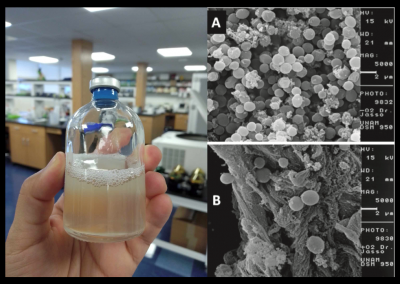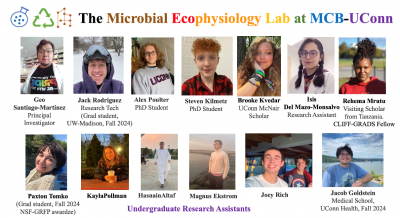The Santiago-Martinez lab uses modern approaches to investigate ancient things.
-by Stacey Hanlon
Cellular life on Earth can be classified into one of three domains: Eukarya (Eukaryota), Bacteria, and Archaea.

Though most of us are familiar with species that fall into the Eukaryota and Bacteria domains, those belonging to the Archaea domain are often ignored despite being found all around us. From the Greek word meaning “ancient things,” archaea are found in a variety of harsh environments like boiling-hot geysers and salt lakes, but they can also be found in the soil and the digestive tracts of several animals, including humans. The Archaea domain was established in the late 1970s after scientists began using genetic sequence (rather than physical characteristics) to classify organisms and reveal how closely they are related[1]. The significant difference between the genetic sequences of microbes that physiologically appeared to be very similar to one another led scientists to establish the Archaea domain to separate these species from Bacteria and Eukaryota.
Within the diversity of Archaea, we can find methane-producing archaea, which are microbes that can produce methane as a byproduct of their unique metabolism in absence of oxygen. Methane is a carbon-neutral biofuel with biotechnological relevance, but also a powerful greenhouse gas and a major contributor to global warming. Methane-producing archaea play a critical role in the cycling of nutrients, yet there are many unknowns regarding the composition and regulation of the metabolic pathways required for this cycling. As lead of the Microbial Ecophysiology Lab, which opened in Fall 2022, Dr. Michel Geovanni “Geo” Santiago-Martínez and his team are working to reveal the secrets of these mysterious microbes. “We are interested in the regulation of metabolic pathways in methane-producing archaea and how they respond to stress,” Dr. Santiago-Martínez says. Currently, Dr. Santiago-Martínez’s research has expanded to focus on methane-producing archaea that were collected from very different environments. “We have two branches. One is investigating methane-producing archaea from marine environments and how they respond to environmental stress conditions, like oxygen and temperature. The other area is methane-producing archaea isolated from the human gut and their preferences for certain unusual substrates, like amino acids and fatty acids, for growth.”
Dr. Santiago-Martínez’s gravitation toward science began when he was growing up in Oaxaca, Mexico, and took an ecology class in high school. His teacher was a nurse who was passionate about teaching. “She showed a love for microorganisms and biodiversity, which got me interested in microbiology,” Dr. Santiago-Martínez says. This early experience fueled his decision to move to Mexico City to the Universidad Nacional Autónoma de México (UNAM) where he received both a B.S. in Biology and Ph.D. in Microbiology. Dr. Santiago-Martínez conducted research as both an undergraduate and graduate student under the mentorship of Dr. Jasso-Chávez Ricardo and studied the metabolism of photosynthetic microbes, then eventually transitioned to investigating the metabolism of methane-producing archaea for his Ph.D. During his dissertation research, Dr. Santiago-Martínez was the first to describe that proteins involved in carbohydrate production in methane-producing archaea are modified post-translationally[2]. This work was significant because, in general, metabolism pathways are fine-tuned via expression levels, but this system allows for the modulation of activity at the protein level instead of at the transcript level, allowing for a rapid, reversible, metabolic response.

After graduating with Honors due to his academic excellence and the high quality of the dissertation research, Dr. Santiago-Martínez became a postdoctoral associate in Dr. J. Gregory Ferry’s lab at Penn State. During his time as a postdoc, Dr. Santiago-Martínez furthered his expertise in archaeal research and established a research program that probes the deep characterization of protein involved in metabolic pathways of methane-producing archaea found in marine environments. Using advanced techniques like total RNA sequencing to profile changes in gene expression and microbiology, Dr. Santiago-Martínez’s team is actively investigating how genes involved in the production of methane, ATP, and biomass are turned up or down in response to stress conditions. “Our lab is unique because other labs are working at the level of genomics and metagenomics, but we are using physiology to identify features that are critical for nutrient cycling,” he says. His team is also pioneering the cultivation of methane-producing archaea isolated from the human gut by defining the optimal conditions for maintaining these microbes in a laboratory. Dr. Santiago-Martínez says that his “long-term goal is to provide the foundation for how to cultivate a diversity of archaeal species and evaluate their metabolism of various carbon and nitrogen sources.” By establishing working protocols for culturing and studying a menagerie of archaea in the lab, Dr. Santiago-Martínez’s team will enable researchers from around the world to conduct important investigations into the biology of these fascinating microbes.

In addition to his passion for science, Dr. Santiago-Martínez is also enthusiastic about cultivating a welcoming environment in his lab, department, and broader scientific communities.“I participate in initiatives promoting inclusion in science. For example, I organize The Archaea Power Hour to build a consortium of people interested in working in archaea around the world. We plan different activities like seminars and network events to bring the field together and with the goal of increasing diverse perspectives in higher education,” he says. Additionally, Dr. Santiago-Martínez is an active mentor in Cientifico Latino, a nonprofit organization to support underrepresented minorities in science, especially for those who apply to (and are currently in) graduate school. This drive to promote a more inclusive and supportive environment combined with his exciting research program investigating microbial metabolism makes Dr. Santiago-Martínez a welcome addition to the faculty of the UConn Molecular and Cell Biology Department.
[1] Woese CR, Fox GE. Phylogenetic structure of the prokaryotic domain: the primary kingdoms. Proc Natl Acad Sci U S A. 1977 Nov;74(11):5088-90. doi: 10.1073/pnas.74.11.5088. PMID: 270744; PMCID: PMC432104.
[2] Santiago‐Martínez, M. G., et al, (2016). The nutritional status of Methanosarcina acetivorans regulates glycogen metabolism and gluconeogenesis and glycolysis fluxes. The FEBS journal, 283(10), 1979-1999. https://doi.org/10.1111/febs.13717